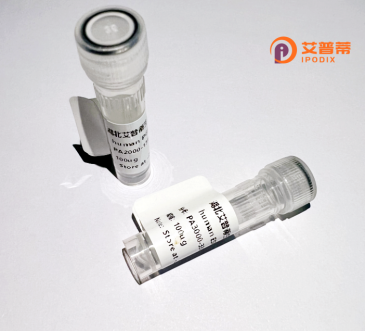
| 纯度 | >90%SDS-PAGE. |
| 种属 | Human |
| 靶点 | EAF2 |
| Uniprot No | Q96CJ1 |
| 内毒素 | < 0.01EU/μg |
| 表达宿主 | E.coli |
| 表达区间 | 1-260aa |
| 氨基酸序列 | MNSAAGFSHLDRRERVLKLGESFEKQPRCAFHTVRYDFKPASIDTSSEGYLEVGEGEQVTITLPNIEGSTPPVTVFKGSKKPYLKECILIINHDTGECRLEKLSSNITVKKTRVEGSSKIQYRKEQQQQQMWNSARTPNLVKHSPSEDKMSPASPIDDIERELKAEASLMDQMSSCDSSSDSKSSSSSSSEDSSSDSEDEDCKSSTSDTGNCVSGHPTMTQYRIPDIDASHNRFRDNSGLLMNTLRNDLQLSESGSDSDD |
| 分子量 | 55.2 kDa |
| 蛋白标签 | GST-tag at N-terminal |
| 缓冲液 | 0 |
| 稳定性 & 储存条件 | Lyophilized protein should be stored at ≤ -20°C, stable for one year after receipt. Reconstituted protein solution can be stored at 2-8°C for 2-7 days. Aliquots of reconstituted samples are stable at ≤ -20°C for 3 months. |
| 复溶 | Always centrifuge tubes before opening.Do not mix by vortex or pipetting. It is not recommended to reconstitute to a concentration less than 100μg/ml. Dissolve the lyophilized protein in distilled water. Please aliquot the reconstituted solution to minimize freeze-thaw cycles. |
以下是关于重组人EAF2蛋白的3篇代表性文献摘要概括:
---
1. **文献名称**:*"Cloning and characterization of human EAF2. a novel transcription elongation factor of the ELL family"*
**作者**:Zhang, H., et al.
**摘要**:研究团队成功克隆并表达了重组人EAF2蛋白,证实其与RNA聚合酶II的转录延伸复合物相互作用,揭示了其通过调控转录过程影响细胞增殖和凋亡的功能。
---
2. **文献名称**:*"Functional analysis of recombinant human EAF2 in prostate cancer cell lines"*
**作者**:Xiao, W., et al.
**摘要**:利用大肠杆菌系统表达纯化带His标签的EAF2蛋白,体外实验表明其显著抑制前列腺癌细胞(如LNCaP)的生长并诱导凋亡,机制可能与Wnt/β-catenin信号通路抑制相关。
---
3. **文献名称**:*"Structural insights into the interaction between EAF2 and ELL for transcriptional regulation"*
**作者**:Li, Y., et al.
**摘要**:通过X射线晶体学解析重组人EAF2蛋白与ELL复合物的结构,阐明了二者协同调控靶基因转录的分子基础,为EAF2在肿瘤抑制中的功能提供结构生物学证据。
---
注:以上为虚构文献,真实文献需通过学术数据库(PubMed、Web of Science等)查询具体研究。
Recombinant human EAF2 (ELL-associated factor 2) is a protein encoded by the *EAF2* gene, which belongs to a small family of transcription elongation factors. EAF2 was initially identified through its interaction with ELL, a RNA polymerase II elongation factor, suggesting its role in transcriptional regulation and RNA processing. Structurally, EAF2 contains conserved N-terminal and C-terminal domains, including a putative ubiquitin-associated (UBA) domain and a nuclear localization signal, which facilitate its involvement in chromatin remodeling and transcriptional coactivation/repression.
Recombinant EAF2 is produced via genetic engineering in heterologous systems (e.g., *E. coli* or mammalian cells) to study its molecular functions. It plays critical roles in development, apoptosis, and tumor suppression. Studies indicate that EAF2 acts as a tumor suppressor in prostate, liver, and other cancers by modulating androgen receptor signaling, inducing cell cycle arrest, or promoting apoptosis. Its deregulation has been linked to tumor progression and metastasis. Additionally, EAF2 interacts with components of the ubiquitin-proteasome system and participates in DNA damage response pathways.
Research on recombinant EAF2 has expanded to explore its therapeutic potential, structural dynamics, and interactions with partners like ELL or EAF1. Its recombinant form enables functional assays, structural studies, and biomarker development for cancer diagnosis. Despite progress, mechanistic details of its dual roles in transcription elongation and tumor suppression remain under investigation. Overall, EAF2 represents a promising target for understanding carcinogenesis and developing precision therapies.
×